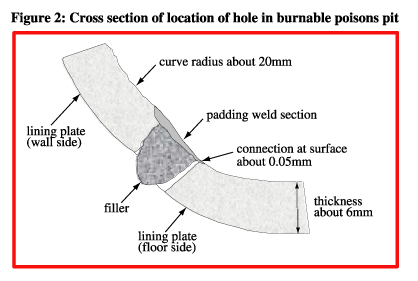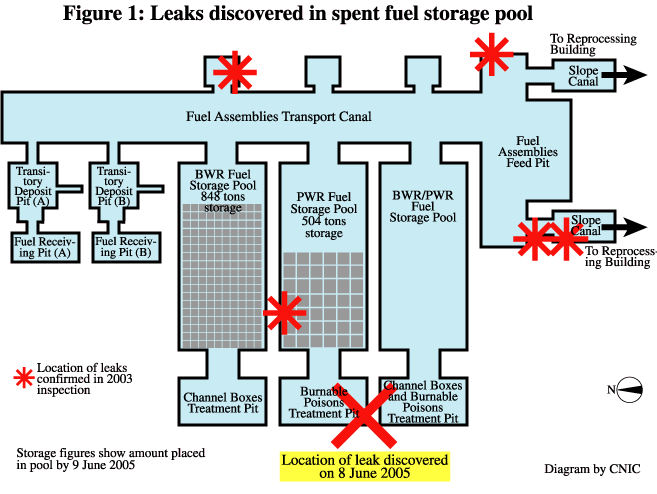Rokkasho Reprocessing Facility another leak from spent fuel pool Nuke Info Tokyo No. 107
On June 8th it was confirmed that there had been yet another leak from the spent fuel storage pool (Figure 1) at the Rokkasho Reprocessing Plant. The location of the leak was a corner of the burnable poisons1 treatment pit for PWR spent fuel. According to a report released by Japan Nuclear Fuel Ltd. (JNFL) on July 12th, two holes, almost connected to each other, were found where padding had been faultily welded, contrary to the approved procedures.
 The whole reprocessing facility is currently undergoing uranium trials (see NIT 104). So that trials using mock-up fuel could be carried out in this pit also, from January to May this year water was drained from the pit and equipment used to cut the burnable poisons was adjusted. The leak was confirmed a few days after the pit had been refilled with water. It is believed that the holes appeared while these adjustments were being carried out. This is plausible, because a stress analysis showed that the weld would not withstand a weight of 100kg applied around 50mm from the weld. During the most recent inspections, this area was checked for signs of post-weld grinding. (Grinding after welding tends to lead to problems later on.) However, nothing was found, perhaps because the surface where the leaks occurred was curved.
The whole reprocessing facility is currently undergoing uranium trials (see NIT 104). So that trials using mock-up fuel could be carried out in this pit also, from January to May this year water was drained from the pit and equipment used to cut the burnable poisons was adjusted. The leak was confirmed a few days after the pit had been refilled with water. It is believed that the holes appeared while these adjustments were being carried out. This is plausible, because a stress analysis showed that the weld would not withstand a weight of 100kg applied around 50mm from the weld. During the most recent inspections, this area was checked for signs of post-weld grinding. (Grinding after welding tends to lead to problems later on.) However, nothing was found, perhaps because the surface where the leaks occurred was curved.
JNFL has adopted the position that leaks are bound to occur over time and the regulating agency, the Nuclear and Industrial Safety Agency, has suggested that it might be sufficient to monitor small leaks (for example, up to 10 liters per hour) without rushing to fix them immediately. Instead, what they should be focusing on is the shoddy workmanship and poor quality control which causes leaks to occur. The government’s inspections system is also called into question once again as a result of this incident.
There have been large scale leaks from the same spent fuel storage pool in the past. Those leaks also resulted from faulty welding. A leak detector attached to the pool detected leakage in July 2001, but the leak wasn’t publicly confirmed until January 2002 (NIT 88, 95). By April 2003, 291 faulty welds, including six actual leaks, had been located. As a consequence major repairs had to be carried out. At the time, six locations in the burnable poisons pit where this latest leak occurred were repaired. For over a year spent fuel could not be loaded into the pool. This led to delays in the uranium trials.
As a result of the latest leak JNFL has announced that for the time being no more spent fuel from power plants around the country will be loaded into the pool. This was unavoidable, since the burnable poisons pit is connected to the rest of the pool. Following the reoccurrence of leakage from the spent fuel pool, numerous questions were raised in the Rokkasho Village Council about JNFL’s quality control system. Also the Nuclear Fuel Cycle Facilities Neighboring Towns Liaison Council, comprising Rokkasho Village’s neighboring towns (Misawa City, Noheji Town, Yokohama Town, Tohoku Town and Higashidori Village) sent a letter of protest to JNFL saying that the safety measures at the facilities were inadequate. Citizens’ groups are demanding that the uranium trials be suspended.
Masako Sawai (CNIC)

